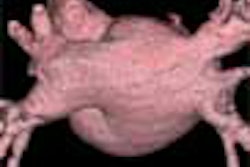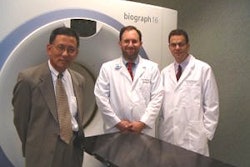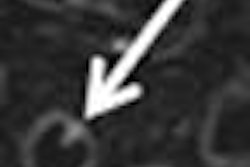Researchers from the Academic Medical Center in Amsterdam have reported that very-low-dose virtual colonoscopy -- as low as 1.4 effective mAs rather than 60 or 80 -- may be a feasible alternative to the standard or even low-dose VC exam.
Their polyp-detection study, published in Radiology online, avoided multiple CT exposures in patients by means of noise-generating filters, enabling the same readers to examine the same patients (weeks apart) at different dose levels. The researchers used Gaussian filters to help them find polyps at the very lowest dose levels.
"In clinical practice, the benefits of CT scanning for the patients generally outweigh the drawback of use of ionizing radiation," Dr. Rogier van Gelder and colleagues wrote. "This balance, however, is very delicate in patients with a low potential benefit, as in the screening of asymptomatic people. Consequently, use of the lowest achievable dose for CT colonography will improve this balance and may serve implementation of this technique in colorectal cancer screening" (Radiology online, June 23, 2004).
While previous studies have shown that low-dose VC is feasible, the dose at which polyp detectability starts to decrease is unknown, they stated.
The study examined 15 asymptomatic patients (10 men, mean age 55 ± 12 years) and five women, mean age 59 ± 13 standard deviation) who had been referred for colonoscopy due to a family history of polyps or cancer, or polypectomy, and were found to have polyps at conventional or virtual colonoscopy.
The aim of the study was to compare polyp detection and interobserver variability at CT colonography using four low to very low doses (as low as 0.05 mSv) with medium-dose VC (8-12 mSv), the authors wrote.
Following purgative bowel cleansing with 4 L macrogol (Klean Prep, Helsinn Birex Pharmaceuticals, Dublin, Ireland), and manual bowel insufflation with a room air/CO2 mixture (87%/13%), the subjects underwent scanning on a multidetector-row CT (Mx8000, Philips Medical Systems, Andover, MA). Scanning was performed at 4 x 2.5-mm collimation, 0.75-sec rotation time, pitch 1.25, 3.2-mm section thickness, 1.6-mm reconstruction interval, at 120 kVp and 100 mAs. (One patient was examined at 60 mAs.) Same-day colonoscopy with sedation was performed on all of the patients within two hours of the virtual exam.
Simulating reduced mAs
The low-dose simulation technique has been honed in several earlier studies, according to the authors. First, calibration measurements using water-filled phantoms were used to determine the number of photons corresponding to each transmission measurement. The photon measurement was then reduced by the generation of a Poisson deviate with a lower mean value, and the Poisson deviate was then converted back into a transmission measurement corresponding to the desired lower tube current time.
"The resulting CT images simulate scans acquired with reduced milliampere-second (mAs) level and thus with proportionally reduced dose," they wrote. "Scans were simulated at 25.0, 6.3, 1.6, and 0.4 mAs, which correspond to effective doses for prone and supine scans together of 3.0, 0.8, 0.2, and 0.05 mSv, respectively. The two lowest doses are not yet achievable in clinical practice, but they are technically possible."
Smoothing of the images at the three lowest simulated mAs levels was also required to detect any polyps due to image noise, by means of standard in-line Gaussian CT filters. The data were evaluated with a primary 3D unfolded cubic projection display mode.
To reduce the possibility of memory bias that could arise with multiple readings of the same patients, at least four weeks passed between repeat reviews of any patient's images by the abdominal radiologist and the research fellow who read the studies. In addition, the scans were read and reread by segments, rather than reading the entire colon at once.
"To guarantee internal validity, we applied five doses in 15 patients to make sure that the differences in polyp visibility were purely a result of the differences in dose," the authors explained.
Results
At conventional colonoscopy, 116 polyps were detected, including 12 polyps 5 mm or larger in the abdominal segments and 15 polyps 5 mm or larger in the pelvic segments, for a total of 27 polyps 5 mm and larger (other findings were excluded for the purposes of the polyp-focused study).
At VC the mean overall sensitivity for detection of 27 polyps 5 mm or larger ranged from 82% at 100 mAs, to 78% at 25 mAs, to 77% at 6.3 mAs, up to 78% again at 1.6 mAs, and down to 48% at 0.4 mAs (these figures, from chart, are approximate). The overall sensitivity decreased with decreasing mAs, but remained 74% or higher down to 1.6 mAs, at which point sensitivity decreased more sharply.
Polyp detection was also slightly lower in the pelvic region than in the abdominal region, particularly at the lowest mAs levels. The only significant detection difference for both observers was at 0.4 mAs (p < 0.05). Also, mean interpretation times at 6.3 mAs for observer 2 and at 1.6 mAs for both observers were significantly lower than those at 100 mAs (p < 0.05), the group found.
Specificity increased or remained constant except at 0.4 mAs, van Gelder and colleagues wrote. For segments with polyps 5 mm or larger, specificity for reader 1 improved from 79% at 100 mAs to 93% at 0.4 mAs. For reader 2, specificity remained between 90% and 96% at all mAs levels. For polyps 10 mm and larger, specificity remained between 96% and 99% at all mAs levels and for both readers.
"Results in this feasibility study indicate that extremely low doses may suffice at CT colonography (VC)," the authors wrote. "This finding might serve other investigators who study the diagnostic value of very-low-dose CT colonography in colorectal cancer screening. With doses down to 0.2 mSv, the mean sensitivity for polyps 5 mm or larger showed a slight but not significant decrease and remained at least 74%, and the interobserver agreement remained constant. Sensitivity values for polyps 5 mm or larger with radiation doses down to 0.2 mSv were within the ranges reported in previous studies..."
"Future studies including patients without polyps will be required to establish the clinical value of very-low-dose CT colonography in terms of patient sensitivity, specificity, and predictive values," van Gelder and colleagues concluded.
By Eric BarnesAuntMinnie.com staff writer
August 3, 2004
Related Reading
Ultralow-dose virtual colonoscopy shows high sensitivity, April 8, 2003
Waist size predicts optimal CT dose in virtual colonoscopy, February 7, 2003
Low-dose CT colonography accurately detects large colorectal neoplasms, July 30, 2002
Ultra-low-dose CT colonography compares with colonoscopy, March 3, 2002
Copyright © 2004 AuntMinnie.com



















